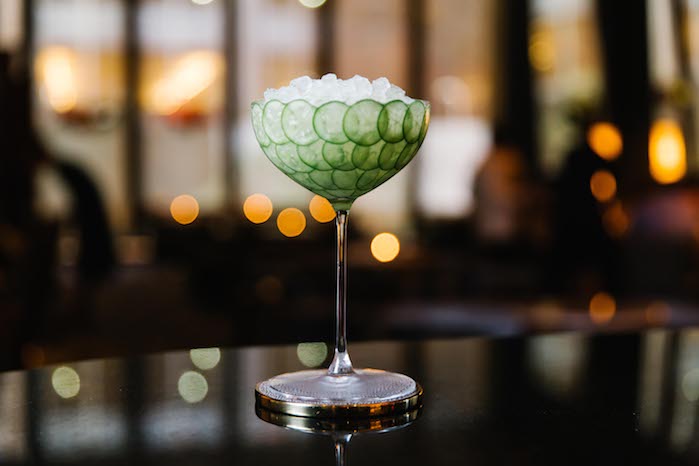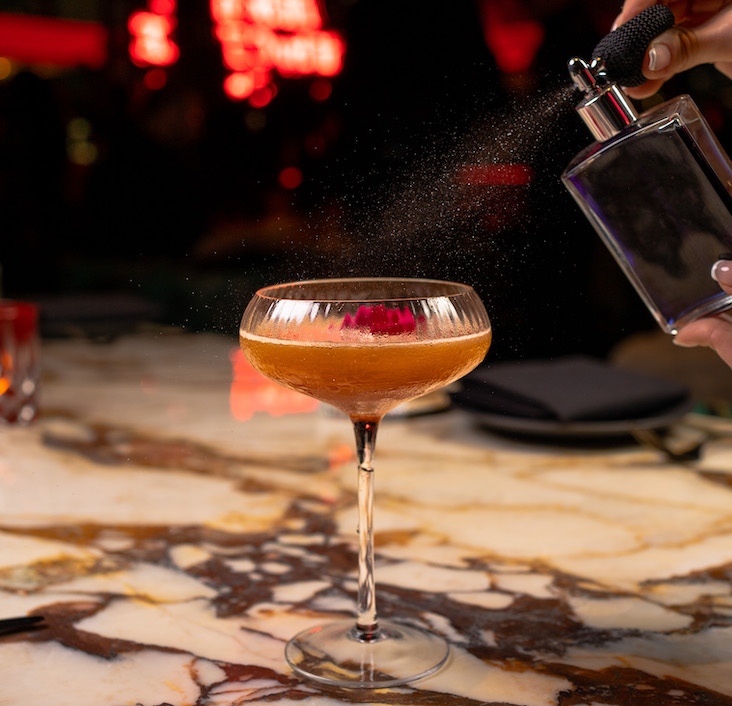You may not see it listed among ingredients on many cocktail menus, but look closely at the backbar and you might spot an eye dropper filled with saline solution. A touch of salt is becoming more common in cocktail recipes as a way to enhance flavors.
Chalino in Portland, OR, uses two drops of a saline solution in its Orange Rhyming Dictionary cocktail with Altos reposado tequila, Banhez mezcal, fresh carrot juice, Cocchi Americano, honey syrup, Fernet Vallet and a bit of citric acid. Academia in Austin, TX, offers a cocktail called Raw Dill, made with Linie aquavit, Dolin Blanc vermouth, St. Germain elderflower liqueur, saline, dill and salmon roe.
Andrea Hoover, beverage operations manager for Columbus, OH-based Cameron Mitchel Restaurants, used saline in a beet-infused gin cocktail she created for the company’s M and The Guild House concepts. Made with Dolin Blanc and chamomile, Hoover describes the drink as a “blonde Manhattan.” The saline “helped bring out the vegetal notes of the gin,” she notes. “It was incredible.”

Orange Rhyming Dictionary cocktail with Altos reposado tequila, Banhez mezcal, fresh carrot juice, Cocchi Americano, honey syrup, Fernet Vallet and a bit of citric acid.
Hoover, who recommends a mixture of 20% kosher salt, 80% hot water, first saw bartenders mixing salt into cocktails in New York a few years ago. At the same time, some of her favorite YouTube bartenders began talking about using saline in drinks.
Now Hoover is a proponent of it herself, and has been traveling the country to teach CMR bartenders about saline in cocktails. The chain includes the 14 locations of the Ocean Prime seafood/steakhouse.
Salt of the Earth
“I think in the most general terms, saline promotes the more hidden flavors lying in a cocktail without becoming an additional ingredient that takes away from whatever you already have going on in that drink,” Hoover says.
For instance, the cocktail menu at M last year included a mint julep made with mint-infused Buffalo Trace bourbon, Amaro, Disaronno and saline, served over a large ice cube with a mint sprig frozen inside.
The saline “elevates the notes of the whiskey, even though the cocktail has a huge mint flavor,” Hoover explains. “The spirit really isn’t muted at all anymore. The saline gives the cocktail a real spirituous backbone.”
Thomas Waugh, bartender/director of bar operations at The Pool Lounge in New York, has been using salt in cocktails and in syrups for years. “In ginger syrups, salt helps make the flavors pop a bit more, while also giving the syrup a texture that’s salty,” he says.
“Using salt can either make something explode flavor-wise, or it can mute flavors you don’t want to mute,” Waugh notes. “Salt and bitterness counteract each other.”
He uses a saline solution of eight parts water to one part sea salt. You need to use quality water and salt, Waugh notes. The Four Seasons offers Vichy water, which already contains minerals and salt. Waugh stores the saline solutions in emptied bitters bottles.

Raw Dill, made with Linie aquavit, Dolin Blanc vermouth, St. Germain elderflower liqueur, saline, dill and salmon roe.
Mixing Saline in Cocktails
Trial and error is key when adding salt to drinks. For instance, Waugh had experimented with salt in his Mango cocktail (made with Japanese whisky, lime, Aperol) to bring out the fruit flavor. But the saline had the unintended side effect of reducing the sharpness and acidity he had wanted for the drink.
But in the Pool Lounge’s Jalapeño cocktail, with jalapeño–infused El Tesoro Platinum tequila, Fortaleza reposado tequila, Cocchi Americano, fino sherry, muddled cucumber wheels and two dashes saline solution, the saline highlights the cucumber and fruit flavors that otherwise might dull when mixed with the other ingredients.
The drink Cucumber (pictured atop) combines two dashes of saline with cucumber–infused absinthe, lime juice, cane syrup and muddled baby cucumber wheels. The infusion process takes away a bit of the bite of the cucumber; adding in saline can help bring back more of that cucumber flavor, Waugh explains.
The saline also subdued the sharp boozy edges of the absinthe. Waugh says that in general, absinthe and salt make an excellent combination. “Salt can really bring out the herbaceous quality of absinthe,” he says.
Another plus: Saline is an inexpensive addition to any back bar. “You always want to make sure you’re being savvy about the money you spend,” Hoover says.
“We used to say that bitters were the salt and pepper of the cocktail,” she notes. “Now you can actually have salt and pepper on your backbar, while adding more colors to the palate.”
Kyle Swartz is managing editor of Cheers magazine. Reach him at kswartz@epgmediallc.com or on Twitter @kswartzz. Read his recent piece 7 Whiskey Trends in 2018.






